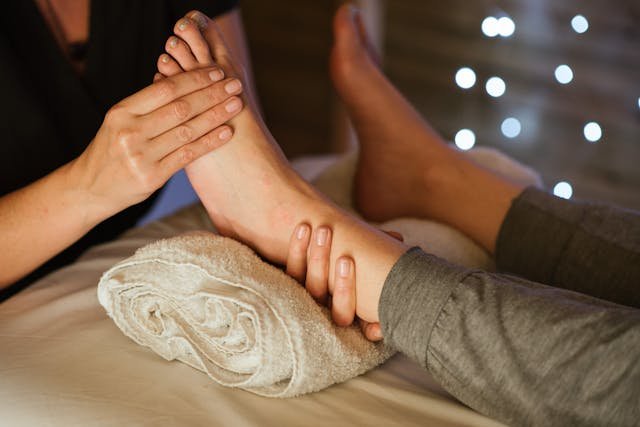If you live with fibromyalgia, you already know that pain can show up in surprising places. Yet, foot pain is often brushed aside, seen as an afterthought compared to the more familiar aches in your back, neck, or shoulders. But in 2025, new research is shining a spotlight on the feet, revealing just how central they are to the fibromyalgia experience. This post unpacks the latest discoveries, offering hope, holistic strategies, and a gentle reminder: your foot pain is real, valid, and worth addressing.
Why Foot Pain in Fibromyalgia Deserves Attention
Fibromyalgia isn’t just about widespread pain, it’s a complex condition that affects nerves, muscles, and even how your brain processes signals. While foot pain may seem minor, it can disrupt your ability to move, sleep, and enjoy daily life. Ignoring it means missing vital clues about your body’s needs. Thankfully, 2025’s research is making it easier to understand, manage, and even anticipate foot pain on your fibro journey.
Let’s walk through the most important findings, one step at a time.
1. Hidden Neuropathic Responses in the Foot
Recent studies have confirmed what many with fibromyalgia have long suspected: nerve dysfunction plays a big role in foot pain. Specifically, small fiber neuropathy damage to the tiny nerves responsible for sensation has been linked to foot specific discomfort in fibro patients. These nerves are easily irritated, leading to burning, tingling, or stabbing sensations.
How to help:
- Practice gentle pressure relief by avoiding tight shoes and using soft insoles.
- Try targeted massage, focusing on the soles and sides of your feet.
- Experiment with warm foot baths to relax nerve endings.
2. Foot Fascia Tightening from Myofascial Dysfunction
The fascia is a thick, web like tissue that wraps around your muscles. In fibromyalgia, this tissue can become inflamed and tight, especially in the feet. New research shows that myofascial dysfunction is a major cause of foot pain, especially after long periods of standing or walking.
Comfort strategies:
- Gentle stretching of the toes and arches in the morning and evening.
- Use of warm packs or heated socks to ease fascia tension.
- Consider myofascial release techniques, either self guided or with a therapist.
3. Gait Imbalance and Structural Shifts
It’s common for people with fibromyalgia to unconsciously change the way they walk to avoid pain. Unfortunately, these adjustments, like rolling your ankles inward or putting extra pressure on your heels can create new problems. In 2025, gait analysis has revealed that these shifts often lead to arch collapse and chronic foot discomfort.
What helps:
- Soft, supportive insoles that cushion pressure points.
- Simple posture exercises to retrain your walking pattern.
- Shoes with proper arch support to maintain foot alignment.
4. Reduced Circulation and Microvascular Dysfunction
If your feet often feel cold or numb, you’re not alone. Research now shows that reduced blood flow caused by capillary constriction is common in fibromyalgia. Poor circulation can make foot pain worse, especially in colder weather.
Boosting warmth and comfort:
- Contrast baths (alternating warm and cool water) to stimulate blood flow.
- Toe flexing and ankle circles throughout the day.
- Wearing thermal socks or using heated foot pads during chilly months.
5. Inflammatory Markers in the Heel and Arch
A landmark 2025 study found elevated inflammatory markers specifically cytokines around the plantar fascia and Achilles tendon in people with fibromyalgia. This inflammation often leads to persistent soreness, especially when you first get out of bed in the morning.
Managing inflammation:
- Choose low impact activities like swimming or cycling.
- Invest in supportive, shock absorbing footwear.
- Try gentle morning stretches before standing.
6. Brain Pain Signal Confusion: Central Sensitization
Sometimes, foot pain isn’t about the foot at all, it starts in the brain. Central sensitization, where the nervous system becomes hypersensitive, is a hallmark of fibromyalgia. New MRI scans show that even without visible damage, the brain can amplify pain signals from the feet.
Calming your system:
- Slow, mindful movement practices such as tai chi or gentle yoga.
- Consistent routines to reduce nervous system “surprises.”
- Mindfulness meditation to help retrain your brain’s response to pain.
7. Hormonal Links to Worsening Foot Pain
Women, especially in midlife, may notice their foot pain intensifies at certain times. Groundbreaking research in 2025 ties estrogen fluctuations to increased discomfort. As hormones shift, collagen in tendons becomes stiffer, making feet more sensitive.
Supporting your feet through hormonal changes:
- Focus on joint friendly nutrition, including omega-3s and fresh produce.
- Engage in gentle mobility exercises to keep tendons supple.
- Stay hydrated to support tissue elasticity.
8. Footwear’s Long Term Effect on Fibro Pain
What you put on your feet matters. A year long study found that unsupportive shoes, especially flat slip-ons or thin soled sandals are linked to higher rates of foot pain flare ups in fibromyalgia.
Choosing wisely:
- Look for shoes with flexible soles, breathable uppers, and ample shock absorption.
- Avoid tight, narrow styles that compress the toes.
- Rotate your footwear to avoid repetitive pressure points.
9. Tarsal Tunnel Syndrome as a Misdiagnosed Culprit
Sometimes, foot pain in fibromyalgia is actually caused by tarsal tunnel syndrome, a condition where a nerve inside the ankle gets compressed. This can cause pain radiating from the heel to the toes, often mistaken for “just fibro.”
Spotting the difference:
- If your pain feels electric or shoots down the foot, ask your doctor about tarsal tunnel.
- New clinical tools can help pinpoint nerve compression.
- Early intervention may include splints, physical therapy, or nerve gliding exercises.
10. Micro-tears in Foot Muscles Due to Fatigue
Chronic fatigue is a core part of fibromyalgia, and it doesn’t just make you tired, it weakens muscles, too. This leaves the small stabilizing muscles in your feet vulnerable to micro tears and injury.
Rebuilding gently:
- Toe lifts and resistance band exercises to strengthen foot muscles.
- Aqua therapy, which reduces strain while building endurance.
- Rest days to allow for healing and recovery.
11. Hidden Vitamin Deficiencies Behind Foot Pain
A comprehensive nutritional review in 2025 uncovered that many with fibromyalgia are low in magnesium, vitamin B6, and vitamin D3. These deficiencies can worsen nerve and muscle dysfunction, especially in the feet.
Nourishing your body:
- Focus on food first options like leafy greens, nuts, seeds, and fatty fish.
- Discuss supplements with your healthcare provider if needed.
- Track your energy and foot comfort as you address deficiencies.
12. Weather Sensitivity and Cold Induced Discomfort
If your foot pain gets worse when the temperature drops, you’re not imagining it. Cold weather causes blood vessels to constrict, triggering sharper pain for many with fibromyalgia.
Warming up:
- Thermal socks and heated insoles for daily use.
- Warm foot soaks with Epsom salts to relax muscles.
- Researchers are even exploring climate reactive fabrics for future wearable relief.
13. Foot Skin Sensitivity and Tactile Triggers
Heightened skin sensitivity is another under recognized aspect of fibromyalgia. In 2025, dermatologists found that even the light touch of socks or sheets can cause discomfort for some.
Soothing sensitive skin:
- Choose seamless, soft cotton socks.
- Use gentle, unscented foot balms to reduce friction.
- Try barefoot grounding (walking on grass or sand) when possible to reconnect with natural textures.
14. Anxiety’s Role in Perceived Foot Pain
Pain isn’t just physical it’s emotional, too. Anxiety can heighten your brain’s response to pain signals, making foot discomfort feel even more intense.
Bring calm to your routine:
- Rhythmic foot tapping or gentle rocking can soothe the nervous system.
- Journaling about your pain experience may help process emotions.
- Consider relaxation techniques like deep breathing or guided imagery.
15. Biomechanical Feedback Loops Between Spine and Feet
Your feet and spine are more connected than you might think. A new biomechanical model shows that tension or misalignment in the lower back can affect nerve pathways all the way down to your feet.
Realigning for relief:
- Gentle pelvic tilts and core exercises to support spinal alignment.
- Posture resets throughout the day stand tall, shoulders back.
- Explore chiropractic care or physical therapy for personalized support.
16. Foot Pain as a Precursor to a Fibro Flare
In 2025, researchers began to recognize that sudden foot sensitivity can be an early warning sign of a larger fibromyalgia flare. Paying attention to these signals can help you prepare and manage symptoms proactively.
Staying ahead of flares:
- Keep a foot specific symptom tracker to notice patterns.
- Adjust your activity and self care routines at the first sign of increased pain.
- Communicate changes to your healthcare team for better support.
17. Water Retention and Puffy Feet in Fibromyalgia
Fluid imbalance and sluggish lymphatic flow can cause swelling and soreness in the feet. This water retention is now recognized as a common, yet overlooked, part of the fibro experience.
Encouraging healthy flow:
- Elevate your feet above heart level for 10-15 minutes daily.
- Gentle movement, like ankle pumps or walking, helps lymphatic drainage.
- Herbal teas such as dandelion or ginger may support fluid balance.
18. Insomnia’s Effect on Foot Recovery
Restorative sleep is essential for healing, but fibromyalgia often brings insomnia. Without enough deep sleep, your body struggles to repair soft tissue including in your feet.
Promoting overnight recovery:
- Address nighttime pain with supportive pillows or ergonomic bedding.
- Establish a calming wind down routine before bed.
- Explore gentle stretches or meditation to ease into sleep.
19. The Gut-Foot Connection
A groundbreaking study in 2025 found that shifts in the gut microbiome can influence inflammation in distant areas, including the feet. An imbalanced gut may worsen nerve and joint pain.
Supporting gut health:
- Incorporate fermented foods like yogurt, kefir, or sauerkraut.
- Add prebiotic rich foods such as bananas, oats, or asparagus.
- Notice whether dietary changes correlate with improvements in foot comfort.
20. Personalized Movement Over Prescription
Perhaps the most important lesson from 2025: there’s no one size fits all approach to managing foot pain in fibromyalgia. What works wonders for one person may not help another.
Finding your path:
- Experiment with intuitive movement and listen to what your body needs each day.
- Make micro adjustments to your routine based on feedback from your feet.
- Celebrate small victories and remain open to new strategies.
Listening to the Feet and the Fibro Story
Your feet are more than just a foundation they’re storytellers, offering clues about your body’s deeper needs. In fibromyalgia, foot pain isn’t random or trivial. It’s a message, urging you to slow down, pay attention, and care for yourself in new ways.
With the latest research illuminating the path in 2025, you have more tools than ever to understand and manage your foot pain. By staying proactive, optimistic, and open to holistic remedies, you can transform discomfort into insight and take confident steps forward on your fibro journey.
Remember, every ache is a whisper from your body. Honor those messages, trust your intuition, and know that with each small step, you’re moving toward a deeper kind of comfort and resilience.










